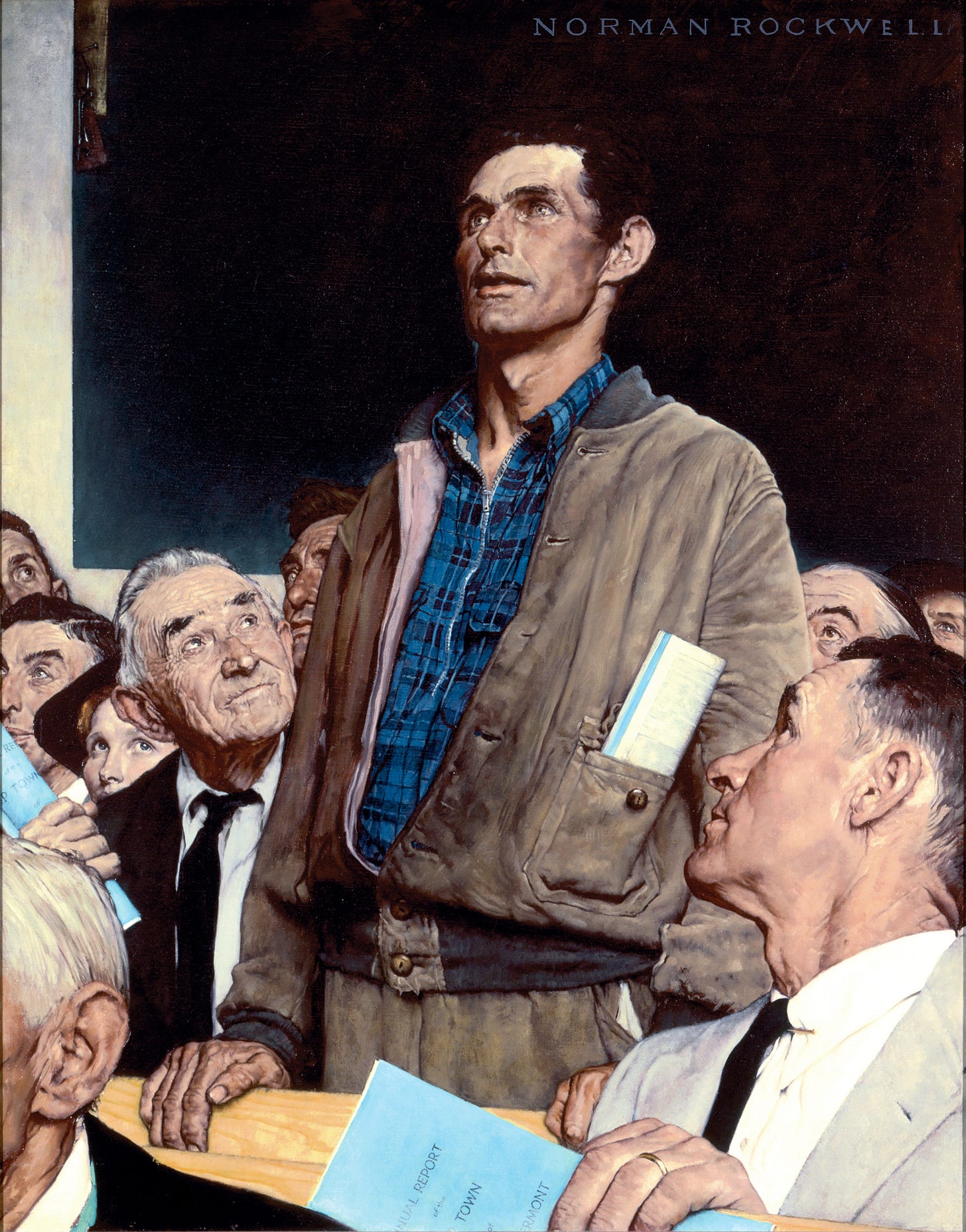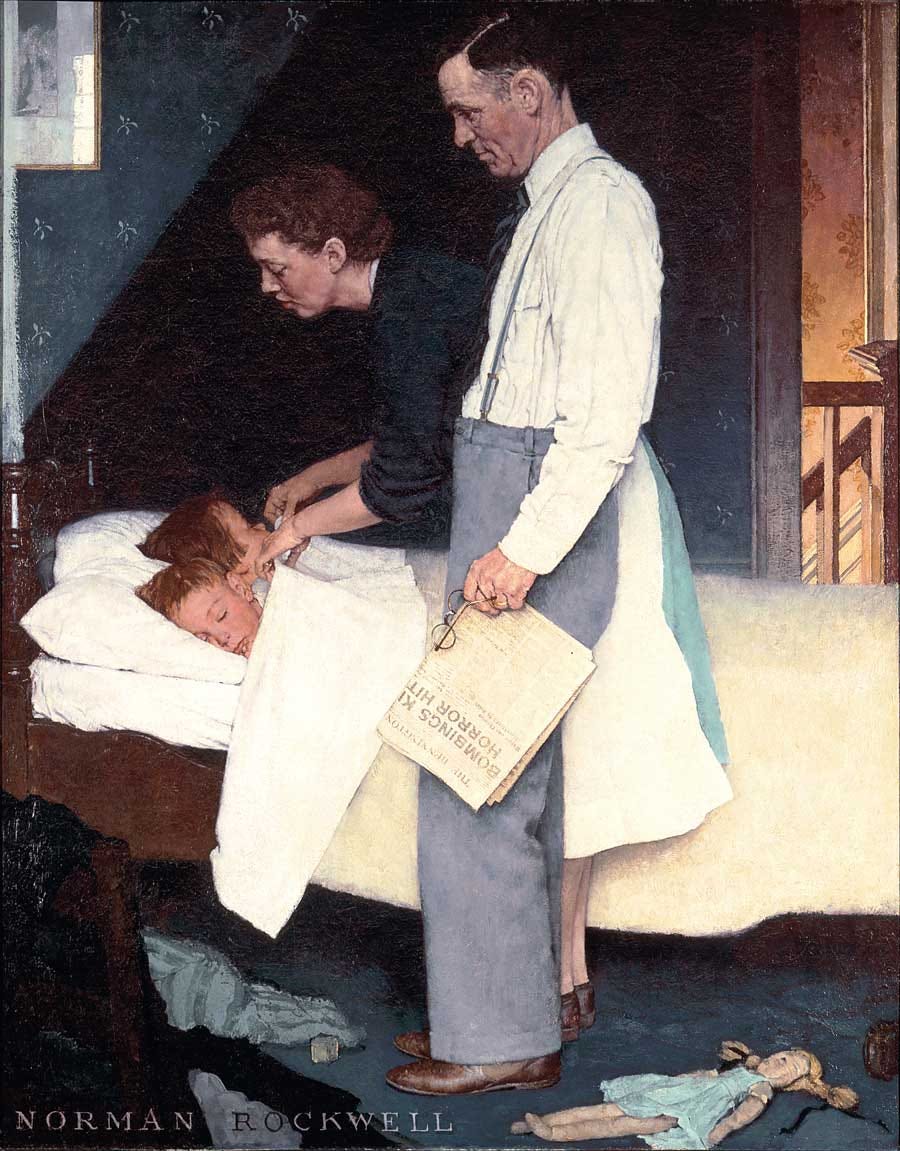Why the Four Freedoms Matter Today
A simple yet powerful values framework still resonates
Americans have much to be grateful for as we mark the Thanksgiving holiday this week. Top of mind for many is relief about our democracy’s durability after months of concern over several threats to the system.
As the tide of immediate mid-term election post-mortems recedes, many in America’s political classes are already starting to turn their eyes to 2024 and the next presidential election. Party strategists and intellectuals are debating questions like how to best approach the upcoming lame duck session and what Biden and a newly divided Congress can get done in 2023. Some are starting to look at ways to expand their bases of support with voters and update their party’s brand.
At times like these, it’s useful to contemplate our country’s foundational principles and reflect on the basic values that have inspired many Americans in previous eras. Examining these deeper ideals can matter as much as the refined data analyses looking at which slices of the electorate voted for which party in the past election.
Accordingly, it’s worth giving the Four Freedoms — freedom of speech, freedom of worship, freedom from fear, and freedom from want — another look. This framework was at the heart of the State of the Union address President Franklin Delano Roosevelt gave in January 1941, just months before America got pulled directly into World War II.
It was a speech aimed at inspiring the nation and unifying it under the common purpose of defending freedom at home and in the world. At the time FDR set forth the Four Freedoms, America was still fully recovering from the Great Depression. What’s more, he had to confront a strong current of isolationism that wielded far greater influence in the public debate — primarily through popular figures like famed aviator Charles Lindbergh — than it had support among Americans.
A few years after the speech and with the United States now fully engaged in the worldwide struggle against Nazi Germany and Imperial Japan, American artist Norman Rockwell depicted these freedoms in four different paintings. He portrayed the Four Freedoms as positive but everyday ideals, things to strive for as a country at home and abroad.
Rockwell sought to convey Roosevelt’s vision for Americans as their country faced war abroad and economic challenges at home. He resisted the temptation to focus his energy on Germany, Japan, and Italy and simply define them as adversaries to defeat. Instead, Roosevelt and Rockwell sought to paint a picture of the world America was fighting to defend and build for all its citizens.
This approach of focusing on what we stand for rather than what we’re against is an approach all of America’s political leaders today could learn from as they craft their agendas for the future.
Freedom of speech
Then: In the early 1940s, America had leaders who utilized the power of the media to unify with a sense of clarity and common purpose — not the other way around as we see today.
The Freedom of Speech painting by Rockwell portrays a vaguely Lincolnesque man he knew named Jim Edgerton making an unpopular argument at a town hall meeting – and everyone else respectfully listening. Indeed, Rockwell later recalled that no one at the meeting shouted Edgerton down despite the fact that no one agreed with him. Hard to imagine that in today’s America.
Now: Americans spend a lot of time and energy shouting each other down — especially on social media, where that sort of anti-social behavior is encouraged, rather than listening to and seeing each other across our divides
Freedom of worship
Then: By most measures, America was a much more religious society in the 1940s, with most Americans reporting back then that they had belonged to a church, synagogue, or mosque. But the acceptance of a diversity of religious backgrounds and views (or lack thereof) back then wasn’t what it is today.
Now: Americans’ membership in religious institutions dropped below the majority last year. But certain groups have deployed religious ideology in political agendas focused on cultural warfare on issues like abortion, prompting some Americans to look for more moderate leaders, as we saw in this month’s midterm elections. The same thing tends to happen in the other direction as well, where political ideologies substitute for religion and adherents aim to impose their own beliefs on the rest of us.
Freedom from want
Then: The global war in the 1940s produced carnage and economic strains around the world, particularly in parts of Europe and Asia overrun by German, Italian, and Japanese armies. Moreover, many Americans still suffered from the lingering aftereffects of the Great Depression — which was itself finally ended in part by wartime production.
Now: America’s economy has bounced back from the forced shutdown in 2020 due to COVID-19 pandemic, but many Americans are still facing economic strains from higher prices due to global supply challenges and perhaps overly aggressive public policies that kept Americans employed and the economy from collapsing. Real wages have taken a hit from inflation over the past year or so, though inflation itself appears to be easing as supply chains unsnarl, interest rates rise, and the economy rewires itself.
Furthermore, the massive wealth and income inequalities that existed before the pandemic have grown larger, and there are signs of a possible global economic recession ahead. America remains the unrivaled economic power in the world today, but its leaders need to work together to boost the ability of our workers and companies to compete. They’ve done that to a certain extent in the current Congress, with tens of billions of dollars in investment in national infrastructure and industrial policy passed by bipartisan majorities.
Freedom from fear
Then: World War II eventually touched every American family either directly or indirectly, with more than 400,000 Americans killed in the war. Rockwell’s Freedom from Fear depicts a young couple tucking their kids into bed at night with subtle hints of war on the horizon in a folded newspaper held by one of the parents.
Now: America is directly and indirectly involved in conflicts across the globe, but none of these are on the order of what we saw during World War II. There are worrisome threats presented by autocratic nuclear powers waging war against their smaller democratic neighbors, and terrorist networks remain a part of the global landscape. But some of the biggest security challenges America faces are at home with a fraying social fabric. Deaths from violent crime, guns, and drugs vastly outpace global security threats and raise tough questions about the free fall in the value of human life in our own communities.
Reading FDR’s original speech and taking in Rockwell’s images transports you back to an era much different than the divided and cacophonous times we're living in now.
Of course, real life is never like a Norman Rockwell painting. But it is good to be reminded of a time when more of our great country's energy and time were focused on moving together towards higher ideals than sniping at one another on social media or paralyzing government with our divisions– or stroking one narcissist’s enormous ego.
America and its democratic system have the unique capacity to regenerate and reinvent themselves. The midterms should give us some sense of optimism that we retain that ability despite all the challenges we’ve faced in recent years. But it’s the next few years that will tell us whether we can live up to its highest ideals as expressed in the Four Freedoms.







